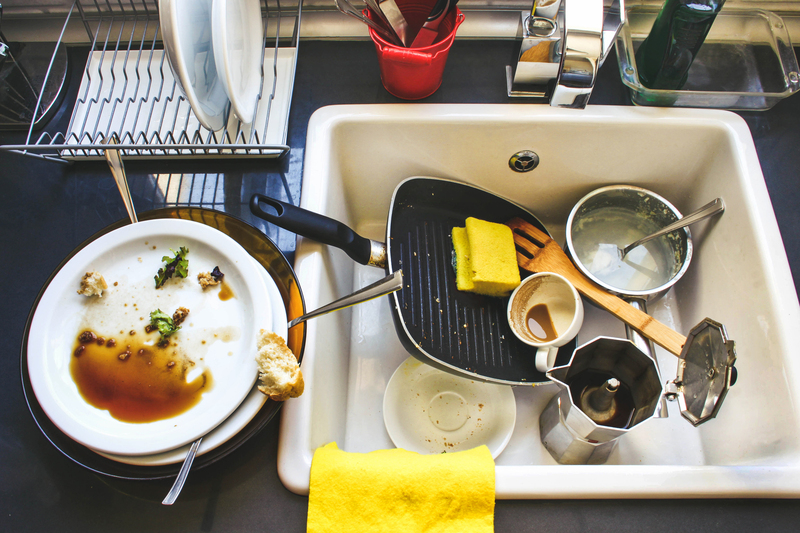Packing Like a Pro: The Dos and Don'ts of Moving House
Moving house can be both exciting and overwhelming. Whether you're relocating across town or to a completely new city, knowing the best packing practices can ease the process and help you avoid common mistakes. This comprehensive guide will walk you through the essential dos and don'ts of moving house--with expert tips on how to pack like a pro for your next move. Read on to discover practical advice, packing hacks, and organizational strategies for a smooth and stress-free transition to your new home.
Understanding the Importance of Packing Properly
A successful move really begins with effective packing. Packing isn't just about putting your belongings in boxes; it involves careful planning, protecting your valuable items, and strategic organizing for quick unpacking at your new space.
Why Does Packing Matter in a House Move?
- Prevents Item Damage: Delicate items need proper protection to survive transit.
- Saves Time: Organized boxes make for a faster, easier move-in process.
- Reduces Stress: Being prepared means fewer last-minute scrambles and lost items.
- Optimizes Space: Smart packing methods help maximize truck space and minimize moving costs.
Packing efficiently means you arrive at your new home with everything intact, sorted, and easy to locate--laying the groundwork for a happy start in your new abode.

The Essential Dos of Packing When Moving House
If you want to move house like a professional, there are vital strategies and steps you shouldn't skip. Here are the top dos for expert moving house packing:
1. Start Packing Early
Procrastinating is a recipe for chaos. Begin packing at least 4-6 weeks before your move-out date. Start with items you use less frequently (such as off-season clothing, books, or decor), and gradually work towards daily essentials. This spreads the workload and reduces stress.
2. Declutter Before You Pack
Moving is the perfect time to assess what you actually need. Sort items into categories:
- Keep
- Donate
- Sell
- Recycle or toss
Less clutter means fewer boxes, lower moving costs, and a cleaner start in your new home.
3. Gather High-Quality Packing Supplies
Cutting corners on supplies increases the risk of breakage. Make sure you have:
- Sturdy cardboard boxes in assorted sizes
- Specialty boxes (for wardrobe, dishes, electronics, etc.)
- Bubble wrap, packing paper, or foam peanuts
- Strong packing tape (avoid masking or duct tape)
- Thick permanent markers for labeling
- Plastic wrap or bags for small pieces and liquids
Don't forget to save your original boxes for electronics and appliances if possible--they offer the best fit and protection for sensitive items.
4. Label Everything Clearly
Write the contents and destination room on every box's top and sides. For added organization, color-code by room or use a numbering system with a master inventory list.
5. Pack Room-by-Room
Focus on one area at a time to maintain order. This helps you stay organized and makes unpacking much easier. For optimal efficiency:
- Finish one room completely before starting another.
- Keep boxes for each room together during the move.
6. Protect Fragile Items
Wrap delicate objects like dishes, glassware, and electronics in several layers of bubble wrap or packing paper. Use sturdy boxes and fill empty space with towels or crumpled paper to prevent movement. Label these boxes "Fragile" so movers know to handle them with care.
7. Create an Essentials Box
Pack a "first-night" box with crucial items such as:
- Medications
- Snacks and water
- Bedding and towels
- Toiletries
- Phone and device chargers
- Basic kitchen items (kettle, cups, utensils)
- Change of clothes
This saves you from frantically searching for necessities the first night in your new home.
8. Disassemble Furniture When Necessary
Take apart beds, tables, and large shelves to make transportation easier and safer. Keep screws and small hardware in labeled bags taped to corresponding furniture pieces.
9. Use Luggage and Bags
Don't let your suitcases, laundry baskets, or gym bags travel empty. Fill them with clothing, bedding, or shoes to maximize space and reduce the number of boxes needed.
10. Take Photos of Electronic Setups
Before unplugging your electronic devices (TVs, computers, stereo systems), take quick photos of the cable arrangements. This makes reassembly much simpler at your new place.
The Don'ts of Moving House Packing
Equally important are the things you should avoid when packing for a house move. Even seasoned movers sometimes slip up on these common mistakes:
1. Don't Overpack Boxes
Heavy boxes risk breaking open or injuring movers. Stick to a 50-pound (about 23-kg) limit per box. Fill large boxes with lighter items (like linens) and small, sturdy boxes with heavier objects (like books).
2. Don't Leave Empty Spaces in Boxes
Items should fit snugly in each box to avoid movement during transit. Use towels, clothes, or additional packing materials to fill gaps and cushion contents, preventing damage from shifting.
3. Don't Mix Items from Different Rooms
Packing random items together leads to confusion and extra work when unpacking. Keep contents from one room in the same boxes whenever possible--this speeds up both the move-in process and organization of your new home.
4. Don't Wait Until the Last Minute
Rushing leads to poor packing, missed details, and lost or broken items. Start early and stick to your timeline to avoid unnecessary panic.
5. Don't Pack Hazardous or Restricted Items
Some materials are illegal or unsafe to transport in moving trucks. These may include:
- Paints and paint thinners
- Aerosols and cleaning solvents
- Propane tanks or gasoline
- Perishable foods
- Fireworks and explosives
Check with your moving company for a full list of prohibited items and dispose of these responsibly before moving day.
6. Don't Forget to Notify Change of Address
It's easy to get caught up in physically moving and forget the paperwork. Update your address with banks, utilities, subscriptions, schools, and the postal service to avoid missing essential mail or bills.
7. Don't Forget to Take Inventory of Belongings
Create a checklist of your packed items--especially valuables--for insurance purposes and peace of mind. This makes unpacking more systematic and helps identify if anything goes missing in the process.
8. Don't Neglect Valuables and Important Documents
Keep passports, jewelry, birth certificates, wallets, and other valuables with you rather than in the moving truck. Use a lockbox or personal bag for these items on moving day.
9. Don't Seal Boxes Without Checking Weight and Padding
Before taping a box shut, do a quick check for adequate padding and manageable weight. Remember: It's better to repack now than repair or replace broken items later!
10. Don't Ignore Labeling Details
Vague or missing labels turn unpacking into a nightmare. Be detailed and consistent with marking your boxes so you'll know exactly what's inside and where it belongs.
Packing Pro Tips for a Hassle-Free House Move
Want to go above and beyond the basics? Try these advanced moving and packing hacks to make your relocation even smoother:
Use Clothes as Packing Material
Wrap fragile items with t-shirts, pillowcases, or towels to both protect them and save on packing supplies.
Seal Liquids with Plastic Wrap
Unscrew cap, put a layer of plastic wrap over opening, and then screw cap back on. This greatly reduces leaks and spills from shampoos, soaps, or kitchen supplies.
Color-Code for Clarity
Assign each room its own color (e.g., blue for kitchen, yellow for bathroom) and use colored tape or stickers on the corresponding boxes for fast unloading and organizing.
Pack Plates Vertically
Similar to vinyl records, standing plates on edge (rather than stacking flat) in a well-padded box reduces the risk of breakage during movement.
Bundle Hanging Clothes
Keep clothes on hangers, wrap tightly together in a clean trash bag or wardrobe bag, and tie the tops. This saves time unpacking and keeps clothes wrinkle-free.
Photograph Serial Numbers and Receipts
For valuables such as electronics, antiques, or artwork, photos of serial numbers and receipts are useful for insurance claims in case of loss or damage.

FAQ: Frequently Asked Questions About Packing for a Move
How far in advance should I start packing for moving?
Begin packing at least 4-6 weeks before your move date, starting with non-essentials. This allows plenty of time to sort, declutter, and pack efficiently without a last-minute rush.
What's the best way to pack clothes for moving house?
- Use suitcases for folded clothes and shoes.
- Transport hanging clothes in wardrobe boxes or by wrapping them securely in trash bags with hangers attached.
- Vacuum-seal out-of-season garments to save space and reduce bulk.
Which items should I keep with me on moving day?
Keep a personal bag containing medications, documents, cash, valuables, snacks, and essentials for pets or children.
Should I hire professional packers?
If your time is limited, you're moving many fragile valuables, or you simply want to avoid the hassle, professional packing services can be a smart investment. They pack quickly and use best practices to protect your belongings.
How do I make unpacking easier after moving house?
- Label every box with room and key contents.
- Unpack room by room, starting with the essentials and the kitchen/bathrooms.
- Refer to your packing inventory list for tracking.
Conclusion: Move Smart, Pack Like a Pro
Packing like a pro means planning, organizing, and executing your move with confidence. By following these packing dos and don'ts for moving house, you'll keep your belongings protected, reduce stress, and make setting up your new home a breeze. Remember:
- Start early and stay organized
- Use the right materials
- Avoid overfilling boxes and mixing items
- Prioritize safety--both for your belongings and yourself!
Whether you're moving just down the street or across continents, these expert tips will help you pack like a pro and enjoy a seamless relocation experience. Happy moving!



